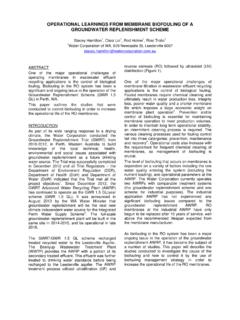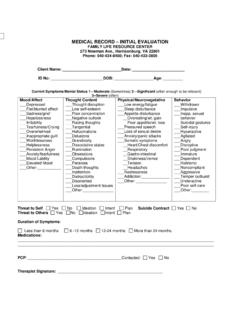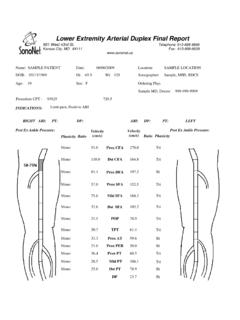Transcription of Colorants and Opacifiers - Linda Arbuckle Ceramics
1 Arbuckle Colorants and Opacifiers Page 1 of 7 Colorants and Colorants and Opacifiers Listed by commonest usage Material Notes Color properties Sources Iron (Fe): In slip: 1/2 - 8% are usual amounts. In glazes up to 15% Found as a source of colors in red clays. Begins to flux at low-fire temperatures. High amounts can increase fluxing in a base glaze, and reduction can increase the activity of iron in a glaze. May be used to modify other Colorants , to modulate cobalt blues or copper colors. Black oxide mix: 4% Fe+ 4% Co + 4% Mn or Cu (note: hi Co may spit in firing and give blue halos on kiln shelves, copper in reduction may give black areas a pink edge quality).
2 + Pb (lead) = amber+ alkaline flux (Na, K, Li) = cooler tones + Zn (zinc) = duller Fe colors + Ca (calcium) = bleached Fe colors In oxidation firing: buff, ochre, rust, browns, and blacks. In glazes 1-3% tans, 4-6% red browns in most, but olive -yellow in high alkali glaze. 6-10% deep browns (tin may help). Presence of barium (toxic) or strontium may produce iron ambers similar to lead colors. In reduction firing: small amounts of iron (.5 - 3%) in a glaze yield celadon greens, blue-greens, olive, and grey-green colors. 1-6% with calcium phosphate (bone ash) = iron blues.
3 Saturated iron (6% or more) in reduction or oxidation glazes with Mg and P , Fe may re-oxidize and form crystals during slow cooling and give "tomato" red, rust, persimmon reds. High Fe also makes brown, and black, temmoku, glazes. red iron oxide (Fe2O3has finer particles than black iron) black iron oxide (FeO) crocus martis (purple-ish raw and in low-fire sigs) rutile (Fe & Ti + impurities), ilmenite (Fe & Ti in powdered or granular form) ochre (yellow ochre) sienna (raw or burnt, Fe + Mn) umber (raw or burnt, Fe + more Mn than sienna) iron chromate (Fe + Cr = taupe colors) Barnard/Blackbird slip clay, Alberta Slip, Albany slip (no longer mined, see Ceramics Mo.)
4 Article Oct. '88 for potential substitutes) Iron sulfate (soluble form avoid skin contact) Resources: Celadons: see (Dec. 98)Studio Potter magazine, Robert Tichane s Those Celadon Blues, historic works: Ice and Blue Clouds. Cultures famous for celadons: Asian (China, Korea, Japan, Vietnam, Thailand, etc.) Copper (Cu): In slip: 2-8%. In glaze: rarely used above 5%. Excess may give metallic pewter. Fluxes at low-fire temperatures and highly soluble in glazes. May vaporize above cone 8 and fume adjacent ware. In raku post-firing reduction copper produces metallic copper penny flashes.
5 2% Cu softens chrome greens in oxidation. "Tizzy" slip for cone 10 reduction is about 8% Cu. + alkaline flux = alkaline turquoise (cf. Egyptian paste turquoise and Islamic wares) + Ba (barium) in high amounts (30% +) = barium blue matts (robin's egg) . High Ba is TOXIC: not for food wares. + Sr (strontium) colors similar to Ba, w/o toxicity. + Zn (zinc) = intensified Cu colors. Oxidation: turquoise to greens. copper carbonate (CuCO3greenish) black copper oxide (CuO) red copper oxide (note: red CuO does not mix well in water and stays beaded up on the surface).
6 Copper sulfate (CuSO4 pale turquoise crystals, soluble, avoid skin contact) Arbuckle Colorants and Opacifiers Page 2 of 7 Colorants and Material Notes Color properties Sources + Pb (lead) = transparent grass green (possibly w/slight lustrous surface) cf. T'ang Dynasty ware. Copper increases the solubility of Pb and may change a "safe" lead glaze to one that leaches Pb. Lead blisters in reduction and is ONLY fired in oxidation. Reduction: copper reds: plum, oxblood, peach bloom, flambe, etc. Resources: Studio Potter magazine Clay # 6 Nov/Dec.
7 '98 Pt 1 and 99 no. 1 pt. 2 article on firing Cu reds by Pete Pinnell, Robert Tichane, Copper Red Glazes. Cultures notes for copper reds: Asian Ceramics . Alkaline turquoise copper colors: Egyptian and Middle-Eastern Ceramics . Colorant in transparent turquoise glazes. Cobalt (Co): In slip .25 - 2%. In glazes .25 - 1%. Strong colorant. Melts at low-fire temperatures. Expensive. Stable in all kiln atmospheres to usually give a blue color. May be overbearing and need softening w/iron, nickel, manganese, High cobalt over-glaze colors ( in majolica blue or black ) or surfaces may spit during firing, leaving a halo on the kiln shelf + Mg (magnesium) = purple to lavenders + Pb (lead) = warm blues + alkaline fluxes (Na, K, Li) = brilliant blue toward ultramarine + Zn (zinc) = intensified blue + Ti (titanium) = green Mixed with Colorants .
8 + rutile or titanium = green + Cr (chrome) = teal + pink stain = purple cobalt carbonate (CoCO3lavender raw) cobalt oxide (CoO black raw) May spot unless sieved well. cobalt sulfate (CoSO4 lavender crystals raw) SOLUBLE. Hazardous. Cultures known for use of cobalt decoration: Chinese Ming dynasty, various SE Asian ceramic traditions. Colorant in Emily Purple high-fire glaze. Manganese (Mn): In slip 2-10%. Over 15% fluxes high-fire slips enough to vitrify. In glaze 2-4% will dissolve in glazes. Over 4% in glaze can produce crystalline Mn on the glaze surface at high temperatures.
9 Over 20% = bronze metallic surface Begins to melt at 1112 F. Brown to plummy brown to purple brown. May produce greens at high temperatures and in reduction. Pinks. Mason s very refractory 6020 pink stain is Mn-Al pink. Often used to modify cobalt colors. May blister if used in large amounts w/ sulfur present. May cause pinholing in glaze surface. All forms: skin contact is not a signficant hazard but highly TOXIC if inhaled, moderately toxic if ingested. (See Hamer on Mn). + high alkaline fluxes (K, Na, Li) and low alumina 1-3% MnO2 = violet.
10 CoO will intensify this color. + alumina in a frit = pink stain ( Mason 6020 pink body stain) + Pb (lead) = purple + tin = interesting coffee color according to Hamer. manganese oxide (MnO)manganese dioxide (MnO2) manganese carbonate (MnCO3). Arbuckle Colorants and Opacifiers Page 3 of 7 Colorants and Material Notes Color properties Sources Chrome (Cr): In slip .50 - 2%. Excess (> 6%?) black breaking to green. In glazes .25 - 2%. Powerful, refractory colorant. Remains undissolved and give opaque, dense color in glazes. Usual color is opaque John Deere tractor green.












